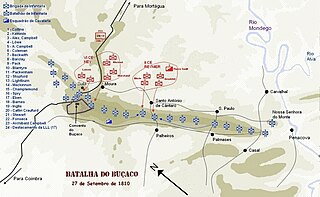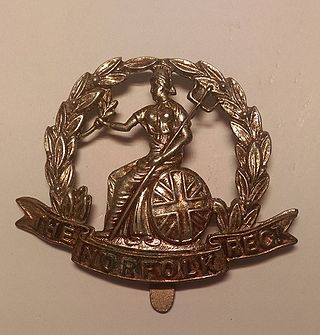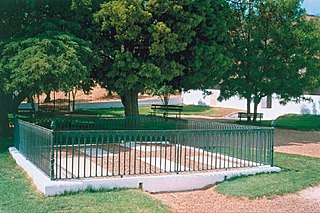This article needs additional citations for verification .(February 2023) |
This is an order of battle for the Battle of Vimeiro that was fought on 20 August 1808.
This article needs additional citations for verification .(February 2023) |
This is an order of battle for the Battle of Vimeiro that was fought on 20 August 1808.

Commander-in-chief: Lt Gen Sir Arthur Wellesley [1]
| Brigade | Regiments and Others |
|---|---|
| 1st Brigade
|
|
| 2nd Brigade
|
|
| 3rd Brigade
|
|
| 4th Brigade
|
|
| 5th Brigade
|
|
| 6th Brigade
|
|
| 7th Brigade
|
|
| 8th Brigade
|
|
| Cavalry
|
|
| Artillery
|
|
| Portuguese detachment
|
|
| Total British and Portuguese force: 19,363 men (16,778 British, 2,585 Portuguese, 16 guns) | |
Commander-in-chief: General of Division Jean-Andoche Junot, duke of Abrantes
| Division | Brigade | Regiments and Others |
|---|---|---|
| Division Delaborde
| 1st Brigade
|
|
| 2nd Brigade
|
| |
| Division Loison
| 1st Brigade
|
|
| 2nd Brigade
|
| |
| Cavalry Division
| ||
| Reserve |
| |
| Auxiliaries
|
| |
| Total French force: 15,656 men (12,705 infantry, 2,251 cavalry, 700 artillery, 23 guns) | ||
There is no exact muster of the French Army of Portugal at Vimeiro, so the unit strength is given for the end of the July.
Sir Charles Oman calculated that the French Army of Portugal at Vimeiro on the day of the battle (20 August) was:
Total force: 13,056

The Coldstream Guards is the oldest continuously serving regular regiment in the British Army. As part of the Household Division, one of its principal roles is the protection of the monarchy; due to this, it often participates in state ceremonial occasions. The Regiment has consistently provided formations on deployments around the world and has fought in the majority of the major conflicts in which the British Army has been engaged.
The Confederate order of battle during the Battle of Gettysburg includes the American Civil War officers and men of the Army of Northern Virginia. Order of battle compiled from the army organization during the battle, the casualty returns and the reports.

The Battle of Buçaco or Bussaco, fought on 27 September 1810 during the Peninsular War in the Portuguese mountain range of Serra do Buçaco, resulted in the defeat of French forces by Lord Wellington's Anglo-Portuguese Army.

The Buffs (Royal East Kent Regiment), formerly the 3rd Regiment of Foot, was a line infantry regiment of the British Army traditionally raised in the English county of Kent and garrisoned at Canterbury. It had a history dating back to 1572 and was one of the oldest regiments in the British Army, being third in order of precedence (ranked as the 3rd Regiment of the line). The regiment provided distinguished service over a period of almost four hundred years accumulating one hundred and sixteen battle honours. In 1881, under the Childers Reforms, it was known as the Buffs (East Kent Regiment) and later, on 3 June 1935, was renamed the Buffs (Royal East Kent Regiment).
This is the complete order of battle of opposing forces at the Battle of Balaclava.

The Royal Norfolk Regiment was a line infantry regiment of the British Army until 1959. Its predecessor regiment was raised in 1685 as Henry Cornwall's Regiment of Foot. In 1751, it was numbered like most other British Army regiments and named the 9th Regiment of Foot.

The 13th Hussars was a cavalry regiment of the British Army established in 1715. It saw service for three centuries including the Napoleonic Wars, the Crimean War and the First World War but then amalgamated with the 18th Royal Hussars, to form the 13th/18th Royal Hussars in 1922.
The following Confederate States Army units and commanders fought in the Battle of Nashville of the American Civil War. The order of battle has been compiled from the army organization during the campaign and reports. The Union order of battle is shown separately.

On 15 June 1944, United States Marine forces landed on the southwest coast of the island of Saipan in the central Marianas chain; these were followed a day later by US Army forces. This invasion was part of Operation Forager, an effort to recapture the entire Marianas chain from the Empire of Japan.

This is the order of battle for both the Russian and German armies at the Battle of Tannenberg, August 17 to September 2, 1914.
The following Confederate States Army units and commanders fought in the Battle of Franklin on November 30, 1864. The Union order of battle is shown separately.

The siege of Yorktown was the culminating act of the Yorktown campaign, a series of military operations occupying much of 1781 during the American Revolutionary War. The siege was a decisive Franco-American victory: after the surrender of British Lt. Gen. Charles, Earl Cornwallis on October 17, the government of Lord North fell, and its replacement entered into peace negotiations that resulted in British recognition of American independence with the 1783 Treaty of Paris.
The 38th Regiment of Foot was an infantry regiment of the British Army, raised in 1705. Under the Childers Reforms it amalgamated with the 80th Regiment of Foot to form the South Staffordshire Regiment in 1881.

The British Cemetery at Elvas, Portugal is one of the oldest British Military Cemeteries in existence. It holds only five known graves but two of these are the only marked graves of the thousands of British soldiers who fell at the Battle of Albuera and another is the sole marked grave of the thousands who fell in the three sieges of Badajoz.
This is the order of battle for the Battle of Albuera. The Battle of Albuera was an engagement of the Peninsular War, fought between a mixed British, Spanish, and Portuguese corps and elements of the French Armée du Midi. It took place at the small Spanish village of Albuera, about 12 miles (20 km) south of the frontier fortress-town of Badajoz, Spain. Marshal Sir William Beresford had been given the task of reconstructing the Portuguese army since February 1809. He temporarily took command of General Rowland Hill's corps while Hill was recovering from illness, and was granted overall command of the Allied army at Albuera by the Spanish generals, Joaquín Blake y Joyes and Francisco Castaños.

The Grenadier Guards is the most senior infantry regiment of the British Army, being at the top of the Infantry Order of Precedence. It can trace its lineage back to 1656 when Lord Wentworth's Regiment was raised in Bruges to protect the exiled Charles II. In 1665, this regiment was combined with John Russell's Regiment of Guards to form the current regiment, known as the 1st Regiment of Foot Guards. Since then, the regiment has filled both a ceremonial and protective role as well as an operational one. In 1900, the regiment provided a cadre of personnel to form the Irish Guards; while later, in 1915 it also provided the basis of the Welsh Guards upon their formation.
The Battle of Toulouse saw a French army led by Marshal Nicolas Soult defend the city of Toulouse against the Marquess of Wellington's British, Portuguese, and Spanish army. The fighting took place on 10 April 1814 and Soult evacuated the city late in the evening of 11 April after suffering defeat. Allied casualties in the bitter fighting exceeded French losses by more than a thousand. Official news of the end of the war did not reach Wellington until the afternoon of 12 April.
The following Confederate States Army units and commanders fought in the final military encounter of the American Civil War, the 1865 Appomattox campaign, which lasted from March 29 to April 9 and resulted in Confederate surrender on April 9 at the Appomattox Court House. Order of battle has been compiled from the army organization during the campaign. The Union order of battle is listed separately.
The following units and commanders fought at the Battle of Salamanca on July 22, 1812 during the Peninsular War.
This is the order of battle for the Battle of Vitoria.